Introduction Listeria Monocytogenes
Did you know that although the number of people infected by foodborne Listeria Monocytogenes is relatively low, Listeria Monocytogenes is one of the leading causes of death from foodborne illness? Next to creating nausea, vomiting, aches, fever and diarrhea, it can also spread through the bloodstream to the nervous system, resulting in meningitis which can be fatal. Listeria Monocytogenes cases are not linked to one specific type of food; they have been traced back to e.g. raw or under‐pasteurized milk; smoked fish and other seafood; meats, cheeses (especially soft cheeses) and raw vegetables.
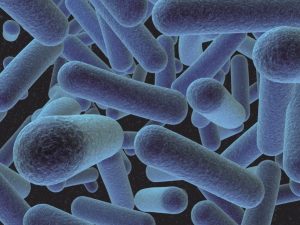 Once you have Listeria Monocytogenes in your factory, you will find it is very difficult to get rid of it. The underlying reasons for this are that Listeria Monocytogenes tolerates salty environments and cold temperatures, it can even continue to grow at temperatures as low as -1.5˚C. Next to this is known that Listeria Monocytogenes will even survive temperatures as low as -25˚C (and lower). So tactics like keeping your product frozen at very low temperatures for a while as a kill step does not work with Listeria Monocytogenes. We must note here that although some manufacturers are using freezing as a kill step this practice should be taken with a lot of precaution.
Once you have Listeria Monocytogenes in your factory, you will find it is very difficult to get rid of it. The underlying reasons for this are that Listeria Monocytogenes tolerates salty environments and cold temperatures, it can even continue to grow at temperatures as low as -1.5˚C. Next to this is known that Listeria Monocytogenes will even survive temperatures as low as -25˚C (and lower). So tactics like keeping your product frozen at very low temperatures for a while as a kill step does not work with Listeria Monocytogenes. We must note here that although some manufacturers are using freezing as a kill step this practice should be taken with a lot of precaution.
As it is difficult to eradicate Listeria Monocytogenes from food, we should focus on the prevention of getting Listeria Monocytogenes contaminations in the first place. This article highlights the five most common areas for finding Listeria Monocytogenes in food factories. Although we focus on food factories all the areas can be easily translated to other areas as well like cold stores, distribution centers, supermarkets and restaurants.
Floors and where to look for Listeria Monocytogenes
Listeria Monocytogenes is present all around us, mainly on dust on the ground. This makes that proliferation of Listeria Monocytogenes is most of the time done via boots. Ensuring boots are clean in the susceptible areas of the factory is a pre-requisite. All places where open food is handled, you want to ensure the boots are clean. This is best done by changing boots in a hygiene sluice or change room. This way you can really enforce the use of clean, for inside use only boots, in your high care environment. Using plastic overshoes is less advisable as it still might give rise to outside dirt setting on top of the plastic. Or even worse: the plastic overshoes might rupture during use and hence you expose your high hygiene area to the risk of Listeria Monocytogenes.
Next to management of boots, it is equally important to keep your factory floors dry at all times. Listeria Monocytogenes as most bacteria needs water to grow and sustain is presence. You should really invest in water management in your factory involving the following factors:
- Guiding all water from the production lines in closed pipes to the drain. Please do not insert the pipe directly into the drain as this might give rise to bacteria growing from your drain into the pipes. Also make sure you properly clean (preferably CIP) the pipes on a regular basis.
- Make sure the floors slope down towards a drain at all times, placing the drain at the lowest point in your floor. This is the only way to prevent pools of standing water, which are a risk for Listeria Monocytogenes and many other problems (e.g. flies).
- In case of a product spill on the floor do not use excessive amounts of water to flush the spill into the drain. It is much better to clean the spill using a plastic brush and tray and only use water (and if necessary cleaning and disinfection agents) to remove the last remains of product from the floor.
Drains and where to look for Listeria Monocytogenes
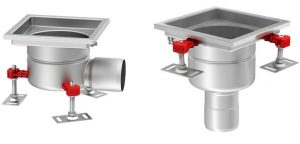 One of the locations you will most certainly find Listeria Monocytogenes when it is present in your factory will be your drains. The main reason for this is that your drains act as a magnifying glass for the biodiversity you have in your factory. This is caused by the fact that most of the time all the dirty water including a lot of the cleaning water is extracted via the drains. Add to this the fact that in quite a few food factories the drains are not of a proper hygienic design, and you and up with a perfect situation for bacteria to enter and grow.
One of the locations you will most certainly find Listeria Monocytogenes when it is present in your factory will be your drains. The main reason for this is that your drains act as a magnifying glass for the biodiversity you have in your factory. This is caused by the fact that most of the time all the dirty water including a lot of the cleaning water is extracted via the drains. Add to this the fact that in quite a few food factories the drains are not of a proper hygienic design, and you and up with a perfect situation for bacteria to enter and grow.
All the above issues are the reason why you want to make sure to install proper, hygienically designed drains in the right locations (lowest point and all the surrounding floors sloping towards the drain). Where do you start looking for properly hygienically designed drains? The best place to start is looking for EHEDG certified drains. These can be found in various places, here are a few examples of websites to start looking at:
Next to using a hygienically designed drain it is also important to keep it clean and sanitized at all times. Otherwise you have just created a fancy and expensive place for the bacteria to sit in. For this reason it is equally important to insert a chlorine tablet in your drain after each cleaning cycle. This way you will keep the standing water in the drain (which will keep the smell out of your factory) clean and sanitized. Each time you have a big spill of water into the drain outside your normal cleaning regime, you want to check if the chlorine tablet is still present. For options to buy the chlorine tablets, have a look at this video.
Equipment
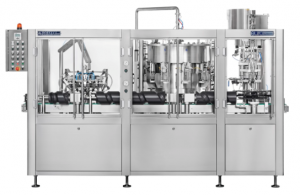 Next to floors and drains you also want to ensure that you do not allow Listeria Monocytogenes to find places to sit and grow in your processing equipment. Typically all the places you can properly clean and disinfect via your CIP system will be safe. The reason for this is that your CIP can only function properly if all the surfaces are smooth and designed for easy cleaning (which means no crevasses and only smooth surfaces and always more than 90 degree bends). Places on your equipment where Listeria Monocytogenes might start building up without being noticed easily are typically those places that need manual cleaning, have crevasses and often have standing water (or show the marks of standing water like calcite deposits).
Next to floors and drains you also want to ensure that you do not allow Listeria Monocytogenes to find places to sit and grow in your processing equipment. Typically all the places you can properly clean and disinfect via your CIP system will be safe. The reason for this is that your CIP can only function properly if all the surfaces are smooth and designed for easy cleaning (which means no crevasses and only smooth surfaces and always more than 90 degree bends). Places on your equipment where Listeria Monocytogenes might start building up without being noticed easily are typically those places that need manual cleaning, have crevasses and often have standing water (or show the marks of standing water like calcite deposits).
The closer to the open product you have spots with frequent standing water on your equipment, the bigger the potential risk of introducing Listeria Monocytogenes into your product stream. Here there is a golden rule: keep the water away from your product at all times. If you have places of standing water on your equipment within 2 meters of your open product you must design it out but changing the equipment design and / or removing the source of water in that location.
Next to the design of the equipment you must be prudent with the use of water any way. You NEVER want to use high pressure water in your hand spraying systems. High pressure water will give rise to aerosols being formed (small drops of water floating in the air). These aerosols are the perfect transportation mechanism for bacteria and might be the perfect way for Listeria Monocytogenes to proliferate in your factory.
Freezer / Cooling system and where to look for Listeria Monocytogenes
Another well-known area where Listeria Monocytogenes can hide is your freezer or cooler systems. All freezer and cooler systems have inside evaporation plates (which are the means through which the cold is spread into the room). These evaporation plates are automatically defrosted on a regular basis to prevent excessive ice build-up on the plates. Behind (sometimes in front) of the evaporation plates you will find a fan which will force the air through the place and hence cool the surrounding area.
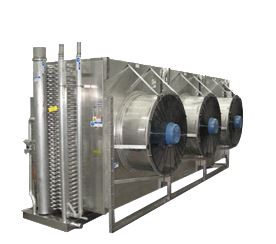
In the prevention of Listeria Monocytogenes it is paramount to keep the evaporation plates clean and sanitized at all times. As we know, Listeria Monocytogenes can survive at very low temperatures and even grow at temperatures as low as -5˚C. For this reason you must ensure you regularly clean and sanitize the evaporation plates and fans of all your freezer and cooling systems.
Companies producing cleaning agents even have developed specialized cleaning liquids and foams for these types of applications. Get in contact with your cleaning product supplier and ask for the specialized products they have for cleaning your cooling and freezer systems. Just in case your supplier does not have these products, have a look at these websites:
- https://www.goodway.com/accessories/coil-cleaning-accessories/coil-cleaner-chemicals-detergents/coilshine-bc-mold-and-mildew-inhibitor-hvac#.WKLUaDvhDDc
- http://www.ecolab.com/program/coil-flo-coil-cleaning-program
- http://www.nalco.com/services/coil-cleaning-sustainability.htm
Air handling system and where to look for Listeria Monocytogenes
Equal to your freezer and cooling systems the air handling system in your factory might use evaporation plates to adjust the air temperature. So all the steps you take for the freezer and cooling systems you need to take for your air handling system as well.
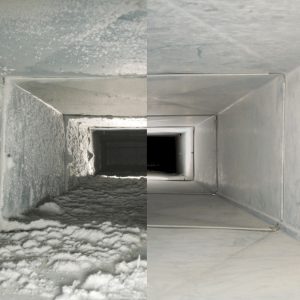 But for air handling systems there is one other dimension you want to take into consideration as well: the likelihood of water build-up (through condensation) inside the air transportation ducts and the air vents entering your factory. It is wise to execute a boroscope inspection (see this video) just after a manual cleaning of your factory (when there is a lot of excess water in the air) to see if there is water build-up in your air handling system.
But for air handling systems there is one other dimension you want to take into consideration as well: the likelihood of water build-up (through condensation) inside the air transportation ducts and the air vents entering your factory. It is wise to execute a boroscope inspection (see this video) just after a manual cleaning of your factory (when there is a lot of excess water in the air) to see if there is water build-up in your air handling system.
Next to Listeria Monocytogenes, air handling systems are also a well-known mechanism through which Salmonella might enter your factory, for more information have a look at our blog on Salmonella Prevention.
Want to have the best support ever?
As a quality & food safety professional, you always have times when you think: “I would like to discuss this with an expert.” Or you wonder how best to tackle a difficult problem and would like to discuss this with an experienced person.
Food Safety Experts’ QFS Success Coaching gives you unlimited access to our experts for a year, when you need it.
Interested? Click here ! Or see : QFS Success Coaching
